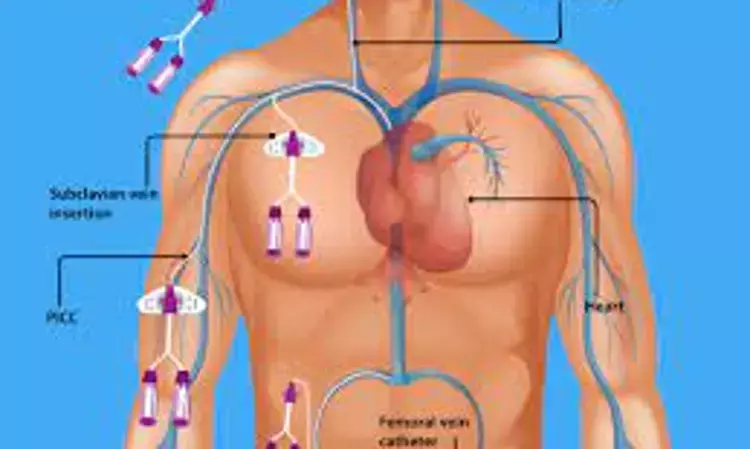- Home
- Medical news & Guidelines
- Anesthesiology
- Cardiology and CTVS
- Critical Care
- Dentistry
- Dermatology
- Diabetes and Endocrinology
- ENT
- Gastroenterology
- Medicine
- Nephrology
- Neurology
- Obstretics-Gynaecology
- Oncology
- Ophthalmology
- Orthopaedics
- Pediatrics-Neonatology
- Psychiatry
- Pulmonology
- Radiology
- Surgery
- Urology
- Laboratory Medicine
- Diet
- Nursing
- Paramedical
- Physiotherapy
- Health news
- Fact Check
- Bone Health Fact Check
- Brain Health Fact Check
- Cancer Related Fact Check
- Child Care Fact Check
- Dental and oral health fact check
- Diabetes and metabolic health fact check
- Diet and Nutrition Fact Check
- Eye and ENT Care Fact Check
- Fitness fact check
- Gut health fact check
- Heart health fact check
- Kidney health fact check
- Medical education fact check
- Men's health fact check
- Respiratory fact check
- Skin and hair care fact check
- Vaccine and Immunization fact check
- Women's health fact check
- AYUSH
- State News
- Andaman and Nicobar Islands
- Andhra Pradesh
- Arunachal Pradesh
- Assam
- Bihar
- Chandigarh
- Chattisgarh
- Dadra and Nagar Haveli
- Daman and Diu
- Delhi
- Goa
- Gujarat
- Haryana
- Himachal Pradesh
- Jammu & Kashmir
- Jharkhand
- Karnataka
- Kerala
- Ladakh
- Lakshadweep
- Madhya Pradesh
- Maharashtra
- Manipur
- Meghalaya
- Mizoram
- Nagaland
- Odisha
- Puducherry
- Punjab
- Rajasthan
- Sikkim
- Tamil Nadu
- Telangana
- Tripura
- Uttar Pradesh
- Uttrakhand
- West Bengal
- Medical Education
- Industry
Increased Number of central line access tied to increased central line associated bloodstream infections

Increased Number of central line access tied to increased central line associated bloodstream infections suggests a new study published in the Critical Care Medicine
Identifying modifiable risk factors associated with central line-associated bloodstream infections (CLABSIs) may lead to modifications to central line (CL) management. They hypothesize that the number of CL accesses per day is associated with an increased risk for CLABSI and that a significant fraction of CL access may be substituted with non-CL routes.
Researchers conducted a retrospective cohort study of patients with at least one CL device day from January 1, 2015, to December 31, 2019. A multivariate mixed-effects logistic regression model was used to estimate the association between the number of CL accesses in a given CL device day and prevalence of CLABSI within the following 3 days.
A 395-bed pediatric academic medical center. Patients with at least one CL device day from January 1, 2015, to December 31, 2019.
There were 138,411 eligible CL device days across 6,543 patients, with 639 device days within 3 days of a CLABSI (a total of 217 CLABSIs). The number of per-day CL accesses was independently associated with risk of CLABSI in the next 3 days (adjusted odds ratio, 1.007; 95% CI, 1.003–1.012; p = 0.002). Of medications administered through CLs, 88% were candidates for delivery through a peripheral line. On average, these accesses contributed a 6.3% increase in daily risk for CLABSI.
The number of daily CL accesses is independently associated with risk of CLABSI in the next 3 days. In the pediatric population examined, most medications delivered through CLs could be safely administered peripherally. Efforts to reduce CL access may be an important strategy to include in contemporary CLABSI-prevention bundles.
Reference:
Ward, Andrew PhD1; Chemparathy, Augustine MS2,3; Seneviratne, Martin MD4; Gaskari, Shabnam PharmD3; Mathew, Roshni MD3; Wood, Matthew PhD3; Donnelly, Lane F. MD3; Lee, Grace M. MD, MPH3; Scheinker, David PhD5; Shin, Andrew Y. MD3,6. The Association Between Central Line-Associated Bloodstream Infection and Central Line Access*. Critical Care Medicine 51(6):p 787-796, June 2023. | DOI: 10.1097/CCM.0000000000005838
Keywords:
Increased, Number, central, line, access, tied, increased, central, line, associated bloodstream, infections, Ward, Andrew PhD1; Chemparathy, Augustine MS2,3; Seneviratne, Martin MD4; Gaskari, Shabnam PharmD3; Mathew, Roshni MD3; Wood, Matthew PhD3; Donnelly, Lane F. MD3; Lee, Grace M. MD, MPH3; Scheinker, David PhD5; Shin, Andrew Y.
Dr. Shravani Dali has completed her BDS from Pravara institute of medical sciences, loni. Following which she extensively worked in the healthcare sector for 2+ years. She has been actively involved in writing blogs in field of health and wellness. Currently she is pursuing her Masters of public health-health administration from Tata institute of social sciences. She can be contacted at editorial@medicaldialogues.in.
Dr Kamal Kant Kohli-MBBS, DTCD- a chest specialist with more than 30 years of practice and a flair for writing clinical articles, Dr Kamal Kant Kohli joined Medical Dialogues as a Chief Editor of Medical News. Besides writing articles, as an editor, he proofreads and verifies all the medical content published on Medical Dialogues including those coming from journals, studies,medical conferences,guidelines etc. Email: drkohli@medicaldialogues.in. Contact no. 011-43720751


